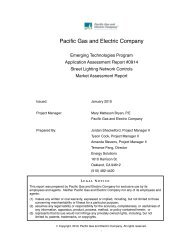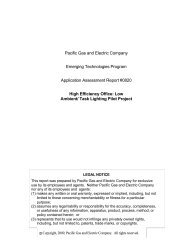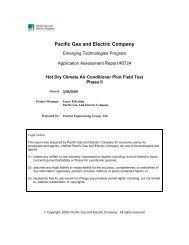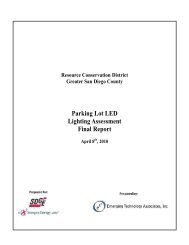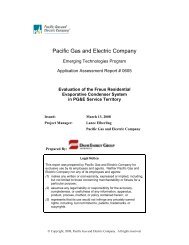Laboratory Evaluation of the OASys Indirect/Direct Evaporative
Laboratory Evaluation of the OASys Indirect/Direct Evaporative
Laboratory Evaluation of the OASys Indirect/Direct Evaporative
You also want an ePaper? Increase the reach of your titles
YUMPU automatically turns print PDFs into web optimized ePapers that Google loves.
to <strong>the</strong> living space through <strong>the</strong> ceiling. There is also no latent load in an evaporatively cooled space<br />
because any moisture generated within <strong>the</strong> space is exhausted and does not need to be condensed out <strong>of</strong><br />
<strong>the</strong> air.<br />
A graphical description <strong>of</strong> <strong>the</strong> difference between <strong>the</strong> two types <strong>of</strong> systems and <strong>the</strong> definition <strong>of</strong> cooling<br />
capacity is shown in Figure 6:<br />
Figure 6: Definition <strong>of</strong> Cooling Capacity<br />
Removed<br />
Heat<br />
(Capacity)<br />
Tsupply<br />
Treturn<br />
CFM<br />
Air Flow<br />
Rate<br />
Conventional Air<br />
Conditioning System<br />
Troom<br />
Internal<br />
Gain<br />
External<br />
Gain<br />
Exfiltration<br />
Infiltration<br />
491-06.12.doc 6<br />
Toutside<br />
qs = 1.08 × CFM × (Tr - Ts) (Sensible Cooling Load)<br />
qt = 4.5 × CFM × (hr - hs) (Total Cooling Load)<br />
( r = room or return s = supply )<br />
External<br />
Gain<br />
Tsupply<br />
Air Flow<br />
Rate<br />
<strong>Evaporative</strong> Cooler<br />
System<br />
CFM<br />
Troom<br />
Internal<br />
Gain<br />
The cooling capacity <strong>of</strong> an evaporative cooler as defined in this report is approximately:<br />
Exfiltration<br />
Room Capacity (Btu/hr) ≈ 1.08 × CFM × (Tdbroom – Tdbsupply) (Equation 2)<br />
where 1.08 is a units conversion factor combining standard air density and specific heat (0.075 lb/ft³ ×<br />
0.24 Btu/lb-°F × 60 min/hr), CFM is <strong>the</strong> flow rate <strong>of</strong> air through <strong>the</strong> unit in cubic feet per minute, Tdbsupply<br />
is <strong>the</strong> discharge dry-bulb temperature <strong>of</strong> <strong>the</strong> test unit, and Tdbroom is an assumed indoor space condition in<br />
°F. The selected room temperature is 80°F, which was chosen since it is what is used for return air in <strong>the</strong><br />
ARI test standards for rating conventional air conditioning systems (Reference 6). This definition means<br />
that if a system is unable to achieve a supply temperature less than 80°F, <strong>the</strong>n its capacity will be negative<br />
(which only means that <strong>the</strong> space will settle out at a higher temperature than 80°F). A test standard from<br />
Australia (Reference 7) lists a similar formula for capacity, but defines <strong>the</strong> interior space condition at<br />
81.3°F (27.4°C). Once a cooling capacity is determined, an energy efficiency ratio (EER) may be<br />
determined by dividing it by <strong>the</strong> total input power in watts.<br />
An evaporative cooler rating parameter has been recently developed by <strong>the</strong> California Energy<br />
Commission (CEC) for its Appliance Efficiency Regulations (Title-20). Their <strong>Evaporative</strong> Cooler<br />
Efficiency Ratio (ECER) uses a slightly modified version <strong>of</strong> <strong>the</strong> above equation for capacity (Equation 2),<br />
which substitutes in <strong>the</strong> equation for effectiveness (Equation 1) solved for <strong>the</strong> supply air temperature, as<br />
follows:<br />
ECER = 1.08 × CFM × (Tdbroom – (Tdb, in – ε × (Tdb, in – Twb, in)) / W (Equation 3)<br />
The effectiveness (ε), power (W), and airflow (CFM) are measured with an external static pressure <strong>of</strong> 0.3<br />
inches <strong>of</strong> water; and in accordance with <strong>the</strong> ASHRAE test standards, with a minimum entering wet-bulb<br />
depression <strong>of</strong> 25°F. The ECER is <strong>the</strong>n calculated at standard rating temperatures <strong>of</strong> Tdb, in = 91°F, Twb, in<br />
= 69°F, and Tdbroom = 80°F. This parameter only looks at <strong>the</strong> sensible cooling done by an evaporative<br />
cooler, and does not reflect <strong>the</strong> increased comfort provided by indirect systems through not adding<br />
moisture to <strong>the</strong> supply air. Thus, this parameter should only be used to compare like-systems (e.g. direct<br />
to direct).




